Article on Hajj:- By: Faizan Ali Pilgrims at the Masjid al-Haram on Hajj in 2008 The Hajj (Arabic : حج Ḥaǧǧ ...
Article on Hajj:-
 The Hajj (Arabic: حج Ḥaǧǧ "pilgrimage") is an annual Islamic pilgrimage to Mecca, and a mandatory religious duty for Muslims that must be carried out at least once in their lifetime by all adult Muslims who are physically and financially capable of undertaking the journey, and can support their family during their absence. It is one of the five pillars of Islam, alongside Shahadah, Salat, Zakat, and Sawm. The Hajj is one of the largest annual gatherings of people in the world but exceeded by the Arbaeen Pilgrimage. The state of being physically and financially capable of performing the Hajj is called istita'ah, and a Muslim who fulfills this condition is called a mustati. The Hajj is a demonstration of the solidarity of the Muslim people, and their submission to God (Allah). The word Hajj means "to intend a journey", which connotes both the outward act of a journey and the inward act of intentions.
The Hajj (Arabic: حج Ḥaǧǧ "pilgrimage") is an annual Islamic pilgrimage to Mecca, and a mandatory religious duty for Muslims that must be carried out at least once in their lifetime by all adult Muslims who are physically and financially capable of undertaking the journey, and can support their family during their absence. It is one of the five pillars of Islam, alongside Shahadah, Salat, Zakat, and Sawm. The Hajj is one of the largest annual gatherings of people in the world but exceeded by the Arbaeen Pilgrimage. The state of being physically and financially capable of performing the Hajj is called istita'ah, and a Muslim who fulfills this condition is called a mustati. The Hajj is a demonstration of the solidarity of the Muslim people, and their submission to God (Allah). The word Hajj means "to intend a journey", which connotes both the outward act of a journey and the inward act of intentions.
The pilgrimage occurs from the 8th to 12th (or in some cases 13th) of Dhu al-Hijjah, the last month of the Islamic calendar. Because the Islamic calendar is lunar and the Islamic year is about eleven days shorter than the Gregorian year, the Gregorian date of Hajj changes from year to year. Ihram is the name given to the special spiritual state in which pilgrims wear two white sheets of seamless cloth and abstain from certain actions.
The Hajj is associated with the life of Islamic prophet Muhammad from the 7th century, but the ritual of pilgrimage to Mecca is considered by Muslims to stretch back thousands of years to the time of Abraham. During Hajj, pilgrims join processions of hundreds of thousands of people, who simultaneously converge on Mecca for the week of the Hajj, and perform a series of rituals: each person walks counter-clockwise seven times around the Ka'aba (the cube-shaped building and the direction of prayer for the Muslims), runs back and forth between the hills of Al-Safa and Al-Marwah, drinks from the Zamzam Well, goes to the plains of Mount Arafat to stand in vigil, spends a night in the plain of Muzdalifa, and performs symbolic stoning of the devil by throwing stones at three pillars. The pilgrims then shave their heads, perform a ritual of animal sacrifice, and celebrate the three-day global festival of Eid al-Adha.
By: Faizan Ali
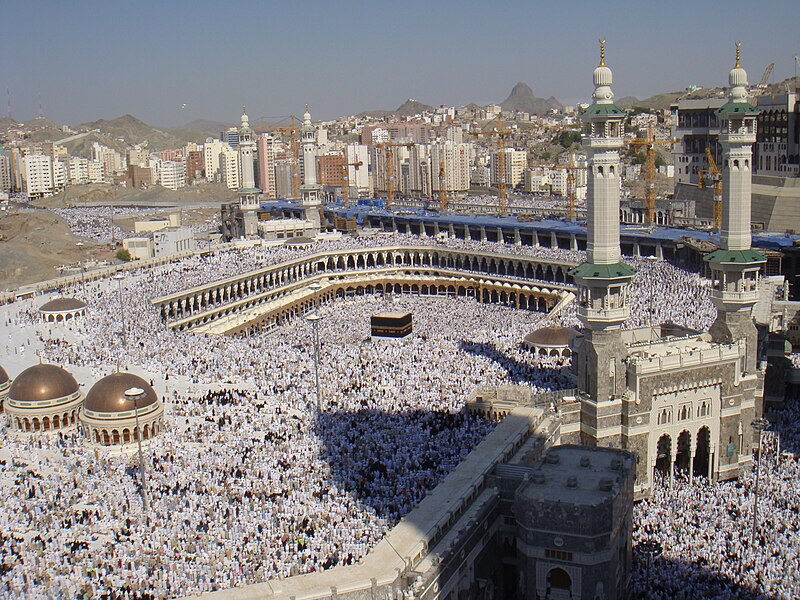 |
| Pilgrims at the Masjid al-Haram on Hajj in 2008 |
 The Hajj (Arabic: حج Ḥaǧǧ "pilgrimage") is an annual Islamic pilgrimage to Mecca, and a mandatory religious duty for Muslims that must be carried out at least once in their lifetime by all adult Muslims who are physically and financially capable of undertaking the journey, and can support their family during their absence. It is one of the five pillars of Islam, alongside Shahadah, Salat, Zakat, and Sawm. The Hajj is one of the largest annual gatherings of people in the world but exceeded by the Arbaeen Pilgrimage. The state of being physically and financially capable of performing the Hajj is called istita'ah, and a Muslim who fulfills this condition is called a mustati. The Hajj is a demonstration of the solidarity of the Muslim people, and their submission to God (Allah). The word Hajj means "to intend a journey", which connotes both the outward act of a journey and the inward act of intentions.
The Hajj (Arabic: حج Ḥaǧǧ "pilgrimage") is an annual Islamic pilgrimage to Mecca, and a mandatory religious duty for Muslims that must be carried out at least once in their lifetime by all adult Muslims who are physically and financially capable of undertaking the journey, and can support their family during their absence. It is one of the five pillars of Islam, alongside Shahadah, Salat, Zakat, and Sawm. The Hajj is one of the largest annual gatherings of people in the world but exceeded by the Arbaeen Pilgrimage. The state of being physically and financially capable of performing the Hajj is called istita'ah, and a Muslim who fulfills this condition is called a mustati. The Hajj is a demonstration of the solidarity of the Muslim people, and their submission to God (Allah). The word Hajj means "to intend a journey", which connotes both the outward act of a journey and the inward act of intentions.The pilgrimage occurs from the 8th to 12th (or in some cases 13th) of Dhu al-Hijjah, the last month of the Islamic calendar. Because the Islamic calendar is lunar and the Islamic year is about eleven days shorter than the Gregorian year, the Gregorian date of Hajj changes from year to year. Ihram is the name given to the special spiritual state in which pilgrims wear two white sheets of seamless cloth and abstain from certain actions.
| Part of a series on |
| Islam |
|---|
 |
|
Pilgrims can also go to Mecca to perform the rituals at other times of the year. This is sometimes called the "lesser pilgrimage", or Umrah. However, even if they choose to perform the Umrah, they are still obligated to perform the Hajj at some other point in their lifetime if they have the means to do so.
History
 |
| A 1907 image of Masjid al-Haram with people praying therein |
In pre-Islamic Arabia, a time known as jahiliyyah, the Kaaba became surrounded by pagan idols. In 630 CE, Muhammad led his followers from Medina to Mecca, cleansed the Kaaba by destroying all the pagan idols, and then reconsecrated the building to Allah. In 632 CE, Muhammad performed his only and last pilgrimage with a large number of followers, and instructed them on the rites of Hajj. It was from this point that Hajj became one of the five pillars of Islam.
During the medieval times, pilgrims would gather in big cities of Syria, Egypt, and Iraq to go to Mecca in groups and caravans comprising tens of thousands of pilgrims, often under state patronage. Hajj caravans, particularly with the advent of the Mamluk Sultanate and its successor, the Ottoman Empire, were escorted by a military force accompanied by physicians under the command of an amir al-hajj. This was done in order to protect the caravan from Bedouin robbers or natural hazards, and to ensure that the pilgrims were supplied with the necessary provisions. Muslim travelers like Ibn Jubayr and Ibn Battuta have recorded detailed accounts of Hajj-travels of medieval time. The caravans followed well-established routes called in Arabic darb al-hajj, lit. "pilgrimage road", which usually followed ancient routes such as the King's Highway.
Timing of Hajj
The date of Hajj is determined by the Islamic calendar (known as Hijri calendar or AH), which is based on the lunar year. Every year, the events of Hajj take place in a five-day period, starting on 8 and ending on 12 Dhul-Hijjah, the twelfth and last month of the Islamic calendar. Among these five days, the 9th Dhul-Hijjah is known as Day of Arafah, and this day is called the day of Hajj. Because the Islamic calendar is lunar and the Islamic year is about eleven days shorter than the Gregorian year, the Gregorian date for Hajj changes from year to year. Thus, each year in the Gregorian calendar, the pilgrimage starts eleven days (sometimes ten days) earlier than the preceding year. This makes it possible for the Hajj season to fall twice in one Gregorian year, and it does so every 33 years. The last time this phenomenon occurred was 2006. The table below shows the Gregorian dates of Hajj of recent years (the dates correspond to 9 Dhul-Hijjah of Hijri calendar):
| 2011 | 2012 | 2013 | 2014 | 2015 |
|---|---|---|---|---|
| 5 November | 25 October | 14 October | 3 October | 23 September |
The approximate date for the next Hajj pilgrimage (1437 AH) is 11 September 2016.
Rites
 |
| Artwork showing locations and rites of Hajj |
Ihram
When the pilgrims reach the appropriate Miqat (depending on where they're coming from), they enter into a state of holiness – known as Ihram – that consists of wearing two white seamless cloths for the male, with the one wrapped around the waist reaching below the knee and the other draped over the left shoulder and tied at the right side; wearing ordinary dress for the female that fulfills the Islamic condition of public dress with hands or face uncovered; taking ablution; declaring the intention (niyah) to perform pilgrimage and to refraining from certain activities such as clipping the nails, shaving any part of the body, having sexual relations; using perfumes, damaging plants, killing animals, covering head (for men) or the face and hands (for women); getting married; or carrying weapons. The ihram is meant to show equality of all pilgrims in front of God: there is no difference between the rich and the poor.
Tawaf and sa'ay
 |
| Direction of the Tawaf around the Kaaba |
Tawaf means walking seven times counterclockwise around the Kaaba. Upon arriving at Masjid al-Haram, pilgrims perform an arrival tawaf either as part of Umrah or as a welcome tawaf. During tawaf, pilgrims also include Hateem – an area at the north side of the Kaaba – inside their path. Each circuit starts with the kissing or touching of the Black Stone (Hajar al- Aswad). If kissing the stone is not possible because of the crowds, they may simply point towards the stone with their hand on each circuit. Eating is not permitted but the drinking of water is allowed, because of the risk of dehydration. Men are encouraged to perform the first three circuits at a hurried pace, known as Ramal, and the following four at a more leisurely pace.
The completion of Tawaf is followed by two Rakaat prayers at the Place of Abraham (Muqam Ibrahim), a site near the Kaaba inside the mosque. However, again because of large crowds during the days of Hajj, they may instead pray anywhere in the mosque. After prayer, pilgrims also drink water from the Zamzam well, which is made available in coolers throughout the Mosque.
Although the circuits around the Kaaba are traditionally done on the ground level, tawaf is now also performed on the first floor and roof of the mosque because of the large crowds.
 |
| Mount Safa near the Kaaba inside Masjid al-Haram |
 |
| Sa'yee towards Al-Safa |
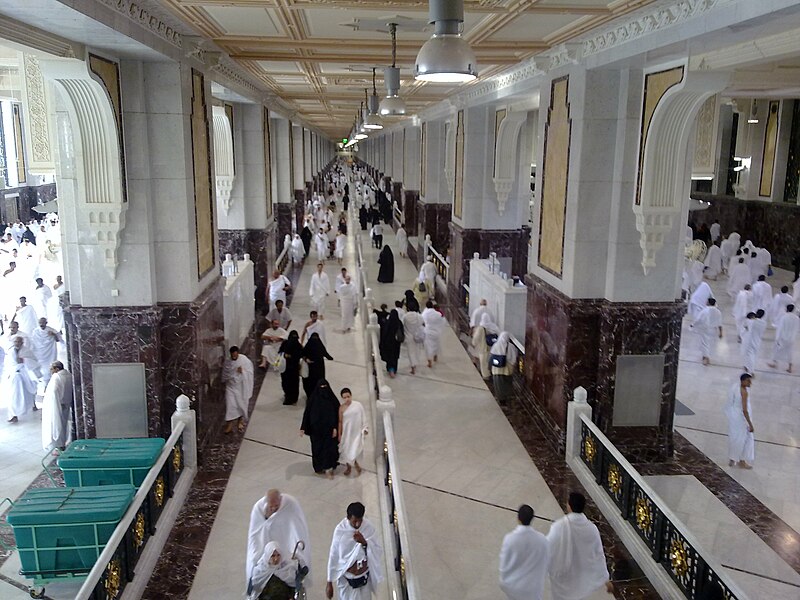 |
| Central section reserved for the elderly and the disabled. Note that it is also divided into two directions of travel. |
 |
| Sa'yee returning from Al-Safa |
First day of Hajj: 8th Dhu al-Hijjah
 |
| Tents at Mina |
Mina
After the morning prayer on the 8th of Dhu al-Hijjah, the pilgrims proceed to Mina where they spend the whole day and offer noon, afternoon, evening, and night prayers. The next morning after morning prayer, they leave Mina to go to Arafat.
Second day: 9th Dhu al-Hijjah
Arafat
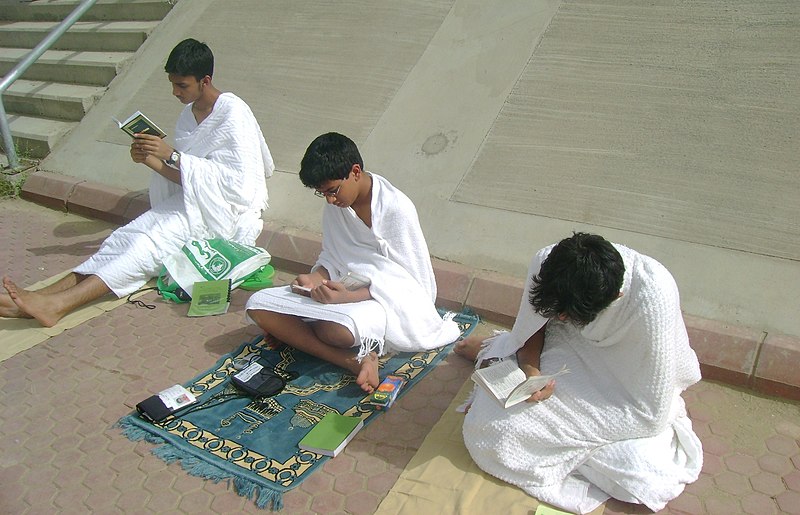 |
| Pilgrims wearing ihram on the plains of Arafat on the day of Hajj |
On 9th Dhu al-Hijjah before noon, pilgrims arrive at Arafat, a barren and plain land some 20 kilometers east of Mecca, where they stand in contemplative vigil: they offer supplications, repent on and atone for their past sins, and seek mercy of God, and listen to sermon from the Islamic scholars who deliver it from near Jabal al-Rahmah (The Mount of Mercy) from where Muhammad is said to have delivered his last sermon. Lasting from noon through sunset, this is known as 'standing before God' (wuquf), one of the most significant rites of Hajj. At Masjid al-Namirah, pilgrims offer noon and afternoon prayers together at noon time. A pilgrim's Hajj is considered invalid if they do not spend the afternoon on Arafat.
Muzdalifah
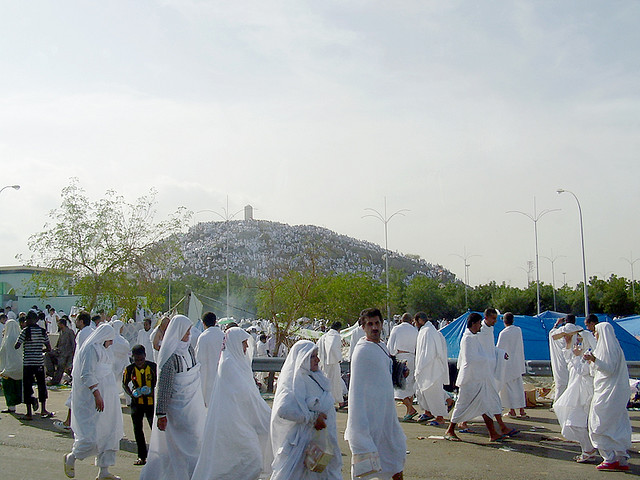 |
| Mount Arafat during Hajj |
Pilgrims must leave Arafat for Muzdalifah after sunset without praying maghrib (evening) prayer at Arafat. Muzdalifah is an area between Arafat and Mina. Upon reaching there, pilgrims perform Maghrib and Isha prayer jointly, spend the night praying and sleeping on the ground with open sky, and gather pebbles for the next day's ritual of the stoning of the Devil (Shaitan).
Third day: 10th Dhu al-Hijjah
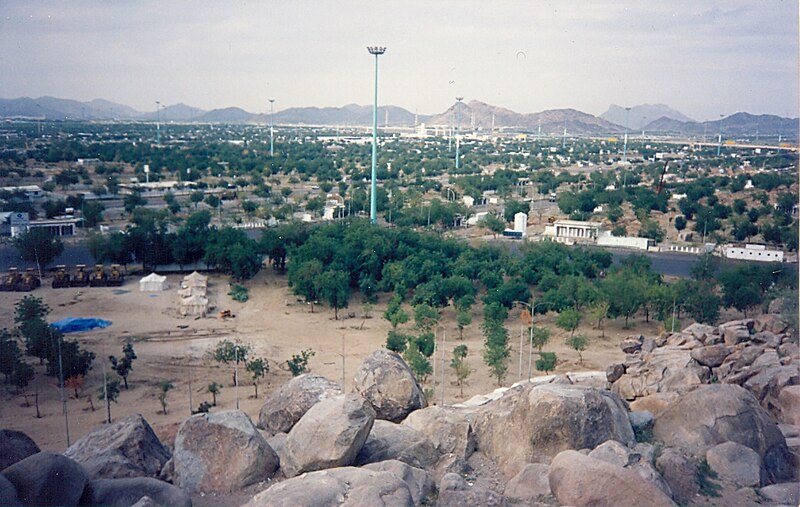 |
| A scenery of Muzdalifa |
Ramy al-Jamarat
Animal sacrifice
 |
| Pilgrims performing Stoning of the devil ceremony at 2006 Hajj |
After the casting of stones, animals are slaughtered to commemorate the story of Abraham and Ishmael. Traditionally the pilgrims slaughtered the animal themselves, or oversaw the slaughtering. Today many pilgrims buy a sacrifice voucher in Mecca before the greater Hajj begins, which allows an animal to be slaughtered in their name on the 10th, without the pilgrim being physically present. Modern abattoirs complete the processing of the meat, which is then sent as charity to poor people around the world. At the same time as the sacrifices occur at Mecca, Muslims worldwide perform similar sacrifices, in a three-day global festival called Eid al-Adha.
Hair removal
Tawaf Al-Ifaadah
Fourth day: 11th Dhu al-Hijjah
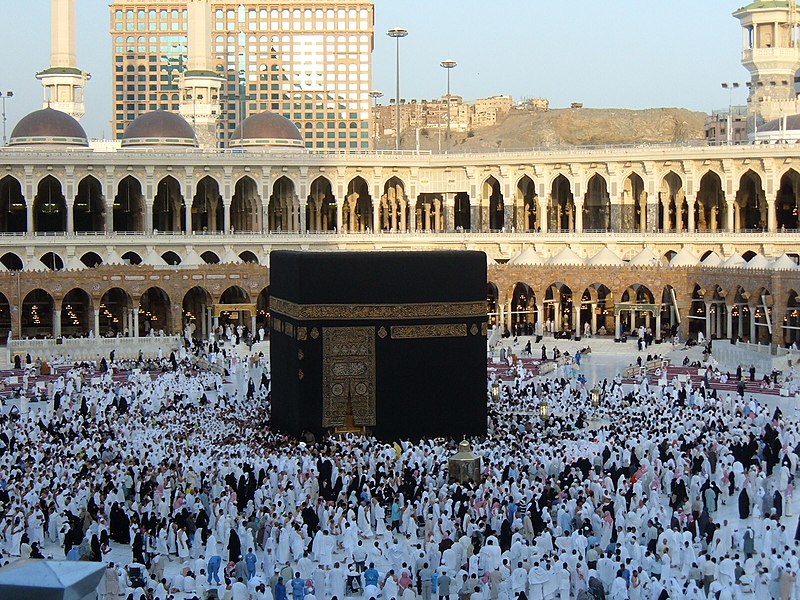 |
| Pilgrims performing Tawaf around the Kaaba |
Fifth day: 12th Dhu al-Hijjah
Last day at Mina: 13th Dhu al-Hijjah
Tawaf al-Wadaa
Journey to Medina
Arrangement and facilities
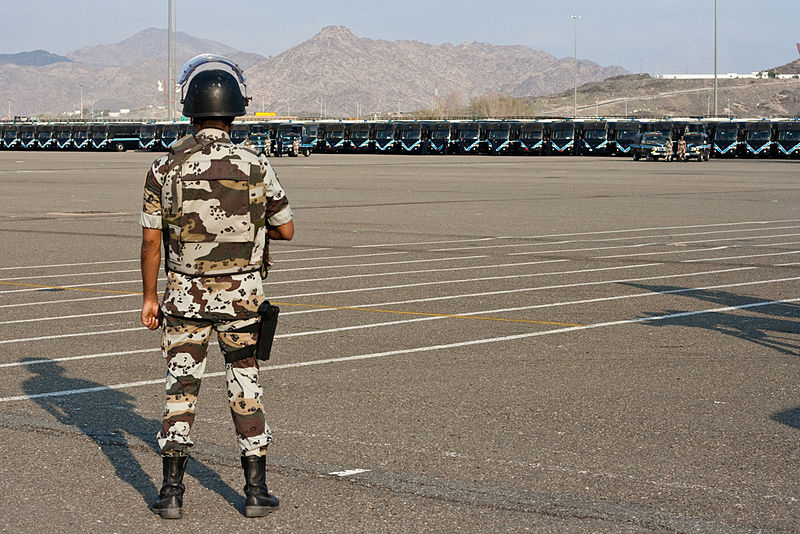 |
| A Saudi security officer on vigil |
Transportation
Pilgrims generally travel to Hajj in groups. During the early 19th century, numbers undertaking the traditional overland pilgrimage within caravans began to diminish as many pilgrims began arriving in Mecca by steamship. This continued for some time, until air travel came to predominate; Egypt introduced the first airline service for Hajj pilgrims in 1937. Today, many airlines and travel agents offer Hajj packages, and arrange for transportation and accommodation for the pilgrims. King Abdulaziz International Airport in Jeddah and Prince Mohammad Bin Abdulaziz Airport in Medina have dedicated pilgrim terminals to assist the arrival of pilgrims. Other international airports around the world, such as Indira Gandhi in New Delhi, Rajiv Gandhi International Airport in Hyderabad, Jinnah in Karachi and Soekarno-Hatta in Jakarta also have dedicated terminals or temporary facilities to service pilgrims as they depart and return home. During Hajj, many airlines run extra flights to accommodate the large number of pilgrims.
Modern crowd-control problems
Even with these crowd control techniques, there are still many incidents during the Hajj as pilgrims are trampled or ramps collapse under the weight of the many visitors. During 2015 Hajj, a stampede resulted in 769 deaths and injuries to 934 others, according to the Saudi authorities. A report from Associated Press totalled at least 1470 fatalities from official reports from other countries, making it the most deadly such episode to date. Concerns were raised in 2013 and 2014 about the spread of MERS because of mass gatherings during the Hajj. Saudi Health Minister Abdullah Al-Rabia said authorities have detected no cases of MERS among the pilgrims so far. He also said that, despite few cases of MERS, Saudi Arabia was ready for the 2014 pilgrimage.
Significance
A 2008 study on the impact of participating in the Islamic pilgrimage found that Muslim communities become more positive and tolerant after Hajj experience. Titled Estimating the Impact of the Hajj: Religion and Tolerance in Islam's Global Gathering and conducted in conjunction with Harvard University's John F. Kennedy School of Government, the study noted that the Hajj "increases belief in equality and harmony among ethnic groups and Islamic sects and leads to more favorable attitudes toward women, including greater acceptance of female education and employment" and that "Hajjis show increased belief in peace, and in equality and harmony among adherents of different religions."
Malcolm X, an American civil rights activist, describes the sociological atmosphere he experienced at his Hajj in the 1960s as follows:
There were tens of thousands of pilgrims, from all over the world. They were of all colors, from blue-eyed blondes to black-skinned Africans. But we were all participating in the same ritual, displaying a spirit of unity and brotherhood that my experiences in America had led me to believe never could exist between the white and the non-white. America needs to understand Islam, because this is the one religion that erases from its society the race problem. You may be shocked by these words coming from me. But on this pilgrimage, what I have seen, and experienced, has forced me to rearrange much of my thought patterns previously held.
 |
| Masjid al-Haram panorama during Hajj, 2007. |
Number of pilgrims per year
There has been a substantial increase in the number of pilgrims during the last 92 years, and the number of foreign pilgrims has increased by approximately 2,824 percent, from 58,584 in 1920 to 1,712,962 in 2012. Because of development and expansion work at Masjid al-Haram, the authority restricted the number of pilgrims in 2013. The following number of pilgrims arrived in Saudi Arabia each year to perform Hajj.| Year | Hijri year | Local pilgrims | Foreign pilgrims | Total |
|---|---|---|---|---|
| 1920 | 1338 | 58,584 | ||
| 1921 | 1339 | 57,255 | ||
| 1922 | 1340 | 56,319 | ||
| 1950 | 1369 | 100,000 (approx.) | ||
| 1995 | 1415 | 910,157 | ||
| 1996 | 1416 | 784,769 | 1,080,465 | 1,865,234 |
| 1997 | 1417 | 774,260 | 1,168,591 | 1,942,851 |
| 1998 | 1418 | 699,770 | 1,132,344 | 1,832,114 |
| 1999 | 1419 | 775,268 | 1,056,730 | 1,831,998 |
| 2000 | 1420 | 466,430 | 1,267,355 | 1,733,785 |
| 2001 | 1421 | 440,808 | 1,363,992 | 1,804,800 |
| 2002 | 1422 | 590,576 | 1,354,184 | 1,944,760 |
| 2003 | 1423 | 493,230 | 1,431,012 | 1,924,242 |
| 2004 | 1424 | 473,004 | 1,419,706 | 1,892,710 |
| 2005 | 1425 | 1,030,000 (approx.) | 1,534,769 | 2,560,000 (approx.) |
| 2006 | 1426 | 573,147 | 1,557,447 | 2,130,594 |
| 2006 | 1427 | 724,229 | 1,654,407 | 2,378,636 |
| 2007 | 1428 | 746,511 | 1,707,814 | 2,454,325 |
| 2008 | 1429 | 1,729,841 | ||
| 2009 | 1430 | 154,000 | 1,613,000 | 2,521,000 |
| 2010 | 1431 | 989,798 | 1,799,601 | 2,854,345 |
| 2011 | 1432 | 1,099,522 | 1,828,195 | 2,927,717 |
| 2012 | 1433 | 1,408,641 | 1,752,932 | 3,161,573 |
| 2013 | 1434 | 700,000 (approx.) | 1,379,531 | 2,061,573 (approx.) |
| 2014 | 1435 | 700,000 (approx.) | 1,389,053 | 2,089,053 (approx.) |
| 2015 | 1436 | 615,059 (approx.) | 1,384,941 | 2,000,000 (approx.) |
Gallery
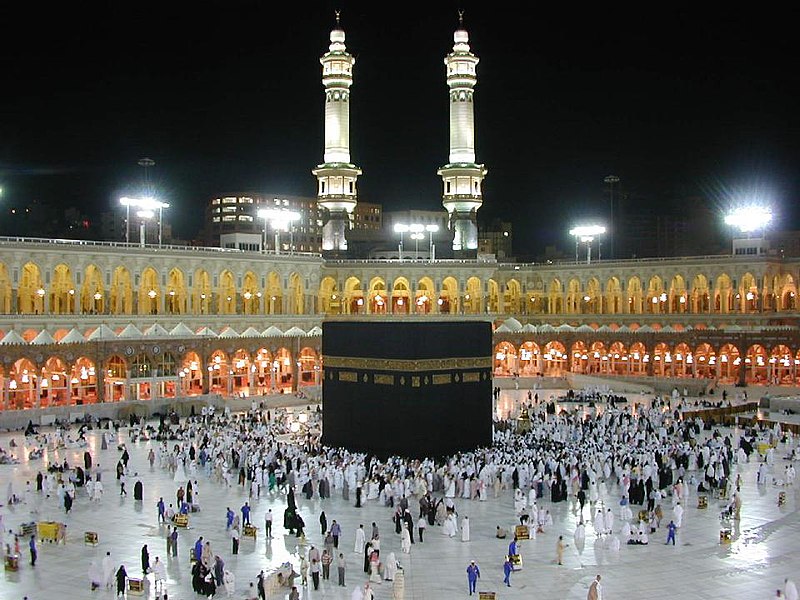 |
| The Kaaba at night time |
 |
| Pilgrim in supplication at Masjid al-Haram |
 |
| The largest Jamarah (pillar) |
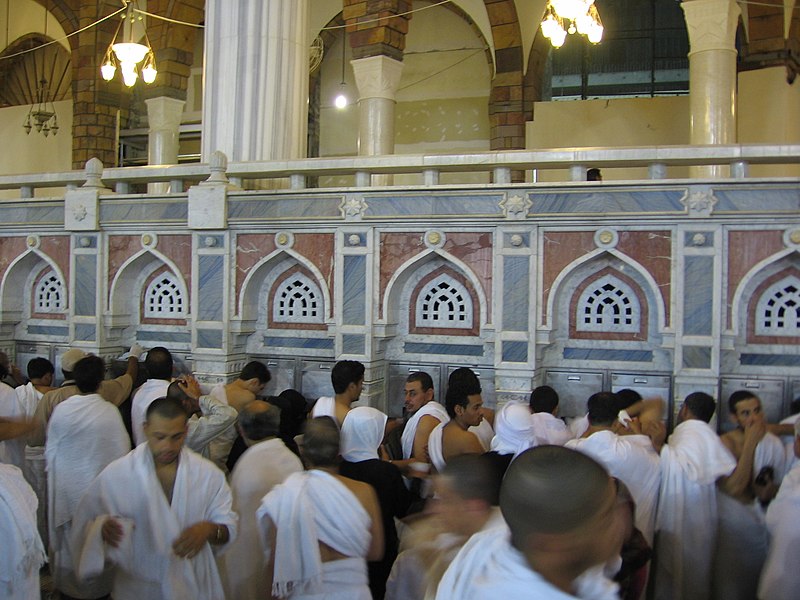 |
| Pilgrims visiting the well of Zamzam |
 |
| Tents at Mina |
 |
| Plain of Arafat during Hajj, 2003 |
 |
| Mount Arafat |
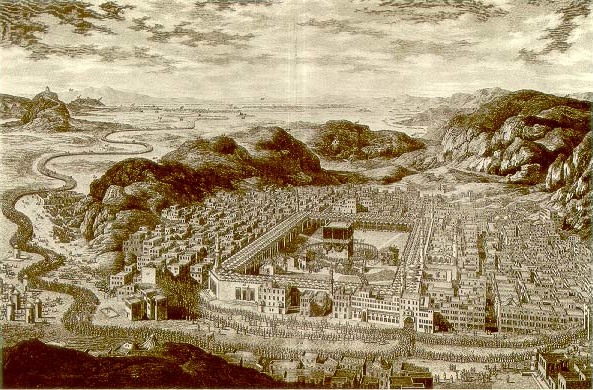 |
| Depiction of Mecca in 1850 |















COMMENTS